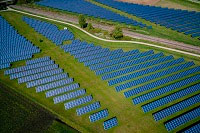
Bankinter avoids emissions equivalent to more than 239,000 tonnes of CO2 thanks to its green bonds
The independent firm ECODES, specialised in green economy, has both calculated savings and drawn up the methodology for the report.
A new addition is the inclusion of solar thermal energy projects in the renewables portfolio.
Bankinter has published its annual report on green bonds for 2021, in which it reveals the estimated positive environmental impact of the green bonds it has issued, for a par value of 750 million euros, on 29 January 2020. The specific monitoring report highlights that the bank has managed to avoid the emission of a volume of CO2 equivalent to 239,457 tonnes over the past year.
New for 2021 was considering new solar thermal projects for project finance and they have been included in the portfolio of renewable energies alongside photovoltaic and wind energy.
ECODES, as an independent advisor, has run calculations and developed the methodology used for the 2021 annual monitoring report. Deloitte has acted as independent verifier.
Reduction in energy use
The savings in emissions were calculated on the basis of generating 1,447 GWh of wind, photovoltaic and solar thermal energy through the renewable assets in which the bonds invest. This has contributed to reducing energy use by 331 MWh in 12 months as a result of financing efficient and green buildings.
The portfolio of green loans financed by these Bankinter bonds is distributed as 85% renewable energy assets, 6% eco-efficient buildings and 9% corporate loans linked to renewable energy companies. Within the renewables portfolio, photovoltaic projects have a weight of 62%, wind projects 25% and solar thermal 13%.
The methodology for calculating emission reductions thanks to the bond is based on the generation of equivalent and comparable scenarios, following the basis proposed in part 2 of the ISO 14062 standard: Greenhouse Gases. Specifications and guidelines, at project level, for quantifying, monitoring and reporting reductions and improvements in the elimination of greenhouse gases. This methodology aims to guarantee impartiality and the use of objective and comparable sources of information, based on internationally recognised standards.
Bankinter is already carbon neutral
The bank is firmly committed to Sustainability and ESG (environmental, social and governance) criteria through the successive plans it has launched over recent years. The 2021-2023 Sustainability Plan is currently in force. It is called "3D", precisely because of the three ESG factors, in which the environmental aspect has significant weight.
The bank has had a neutral carbon footprint since 2020.